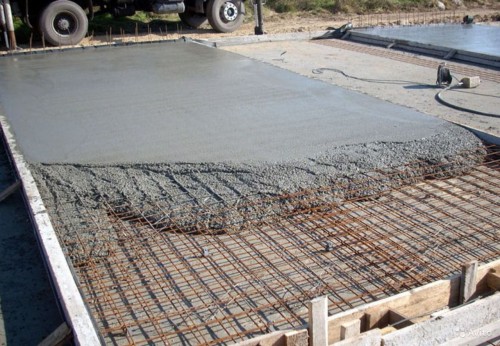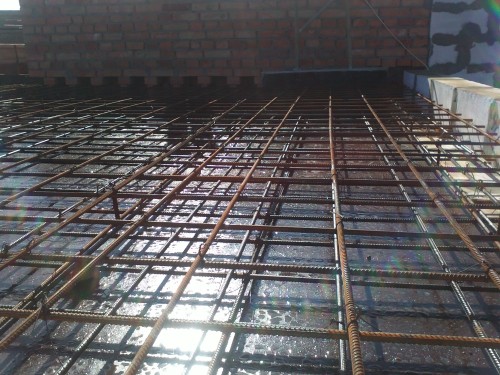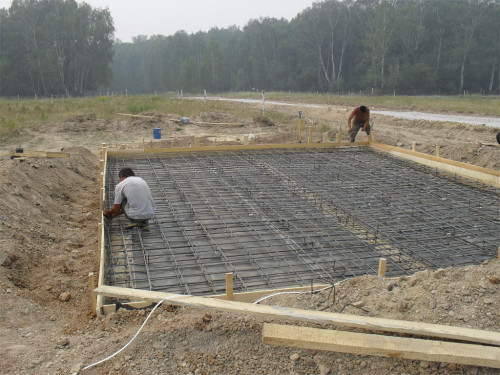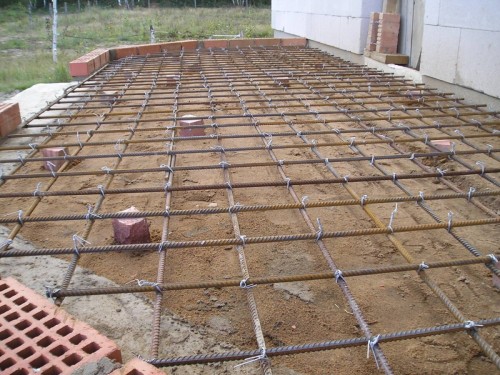If we are talking about creating a foundation, it is almost always implied to the use of high-quality reinforcement. This component, as is well known, significantly improves the strength properties of the base, no matter how massive it is.
Content
Today, people create reinforcement even for those foundations that do not have to perceive too large loads. It is still present that the need for reinforcement is still present. It is also worth paying attention to the fact that even the most elementary options for strengthening the foundation significantly improve its strength.
If we are talking about monolithic foundations that have a solid concrete basis, then high-quality reinforcement is also required. Moreover, it should have a specific scheme, since often such solid foundations are used for structures creating colossal loads. It also makes sense to draw attention to the fact that much may depend directly from the reinforcement scheme. In any case, the foundation will be highly durable, but in some cases it makes sense to take advantage of all possible resources of the concrete structure.
There are really many aspects to pay attention to the reinforcement of the foundation. Specialists call the reinforcement process in the most important thing when creating the basis of the structure, since the total strength and durability of the future structures depends on it.
In this article, we will analyze all issues related to the reinforcement of the monolithic foundation. Often, the owners are wondering, and whether it is possible to carry out such events to carry out such events, and the answer here is unequivocal - you can. However, it is necessary to be extremely attentive and responsible, since these are responsible tasks, which cannot be failed.
Features of the creation of a monolithic foundation
If we are talking about a monolithic foundation, then often the construction created on the basis of solid reinforced concrete elements is intended. This may be the base of tile, ribbon or pile type. It is obvious that the use of one or another type of foundation depends on the specific conditions, or even the preferences of the owners.
The very monolithium of reinforced concrete is a guarantee of reliability and durability of the structure. Construction companies or organizations that are engaged in creating such structures ensure that the construction will differ high reliability of dozens, and even hundreds of years. Of course, the features of the Construction itself are taken into account. It is possible that this is a multi-storey building that will create large load on the foundation. It is especially important if the building is strongly operated, inside there will be many equipment and other devices that will have some impact on the foundation, no matter how strong it is. Therefore, it all depends on the existing conditions.
Often, if the foundation is created, there is already a certain plan or a project that includes basic information.
It is also worth noting the fact that the creation of a monolithic foundation is a fairly simple event that even beginners forces. Of course, without a sufficient number of information, you should not even try to implement something, as the consequences may be too deplorable. In addition, it can be guaranteed that even after studying materials about creating a monolithic foundation, there are many questions that it is advisable to discuss directly with specialists. It is impossible to take any controversial solutions, as you can ultimately be faced with too serious problems.
Device of monolithic foundation
Obviously, metal fittings and concrete mixture are the main components of the monolithic foundation. As for the concrete directly, a durable stone mass is formed when frozen, which is characterized by high resistance to compressive loads. If we talk about the reinforcement, it is a kind of skeleton, which distributes the load throughout the concrete structure. Thus, without reinforcement, the foundation will quickly come into disrepair. In places where large loads will be present, cracks are formed, after which the general destruction of the foundation should be expected.
Advantages and disadvantages of monolithic foundation
As we have said, the monolithic foundation has many positive sides. However, do not forget about the shortcomings of this design. This information will allow not only the features of this type of foundation, but also to analyze the issue of reinforcement.
The advantages of the monolithic foundation:
- Easy to create. It has already been mentioned that the process of creating a monolithic foundation itself is not difficult. In addition, there are no longer preparatory activities. It is enough to study technology well, as well as consult with professionals if necessary. If the foundation is not different, it is not too big dimensions, you can do without technique and special devices.
- Strength. As we have said, the monolithic foundation is characterized by high strength. This suggests that such a basis will be extremely difficult to expose the deformations. This aspect is especially important for the reason that the construction may have some specifics. For example, there may be a variety of equipment that can create a destroyer effect on any other type of foundation.
- Resistance to seasonal soil changes. It often happens that during seasonal changes in the soil, for example, during freezing, the soil can be deformed. At the same time, the position and foundation change somewhat. With a monolithic foundation, nothing like this happens, as it has a specific design. Only in the winter the foundation and all the construction will be a little climb, and in the spring - to descend.
- Saving. It is worth considering the fact that the monolithic foundation is a large one-piece construction, which can become a kind of "draft" floor of the structure. Accordingly, it can be noted savings, which in some cases may be quite large. Of course, the monolithic plate can be only a base surface, so the usual coating by which people will move, still have to create in any case.
Disadvantages of monolithic foundation:
- Price issue. Many owners refuse the monolithic foundation for the reason that the cost of its creation is too high. It is impossible to definitely say what the difference between the cost of creating one or another base, but the monolithic foundation is more expensive than a columnar foundation, as well as some other types of bases. The decision on the creation of a foundation for the construction is extremely responsible, so the cost of construction work is analyzed extremely seriously.
- Specificity of terrain. Experts note that it is possible to create a monolithic foundation only on areas that do not have significant slopes. In such situations, you can pay attention to other types of foundations that can be constructed even on the most specific soils. If you speak directly about the monolithic foundation, then in this case the design has such dimensions that are suitable only for exclusively gentle areas.
- Lack of cellar and basement. As we have already spoken, the foundation is a monolithic structure that does not allow you to create any basement, as well as cellars. It is worth saying that this is quite a serious minus, as many people who plan to build their own home wish to have a place to store things or conservation. Obviously, there are situations when there is no possibility to create some other foundation, and then you have to look for some decision. Again, in this situation, you need to analyze every aspect that can affect accommodation in the house. Perhaps the presence or absence of a cellar can be a decisive factor.
Thickness of monolithic foundation
Before analyzing the situation associated with the reinforcement of a monolithic base, attention should be paid to the thickness of the monolithic plate.
It is important to remember that often such issues are analyzed by experts who have enough experience and opportunities to create the highest quality design. Therefore, it is not necessary to personally make such solutions, since it depends too much. As a last resort, if there are no other options, you can simply have consultations from knowledgeable people.
- First of all, the thickness of the slab foundation depends on the existing soil. There are several types of soils that can affect the operation of fundamental structures in different ways. Accordingly, depending on the soil, it may be necessary to create a more massive foundation, and this will entail increased financial spending.
- The weight of building materials is another factor that affects the thickness of the foundation. It is worth analyzing the mass of all the additional elements of the design to take the most faithful solution related to the base thickness.
- In rare cases, experts advise paying attention to various changes associated with climate, wind loads. Of course, in the overwhelming majority of cases, these factors do not have any influence on the choice of size of the foundation. However, do not forget about the specifics of the area where the basis will be created.
Reinforcement of monolithic foundation
Specificity of reinforcement
First of all, it is necessary to remember that for the maximum efficiency of the monolithic foundation, reinforcement is unevenly. The thing is that in places of resting walls needed additional efforts. Experts call such places to the junctions of the junction.
It is also worth paying attention to the fact that in one layer the valve is placed only if the thickness of the monolithic plate is 150 mm or less. In the event that the foundation thickness is more than 150 mm, the framework of frames occurs.
Plate width
It is worth considering the specifics of creating a mesh in the width of the monolithic plate. It is most important to remember that the pod of the rods in all directions should be the same. Often this step ranges from 200 mm to 400 mm. For example, if we are talking about the construction of a brick structure, the most optimal will be a step in 200 mm. In some cases, when the construction will be a skeleton building, it makes sense to make a smaller step.
Also worth paying attention to the standards, in particular, those related to "concrete and reinforced concrete structures". The bottom line is that the step between the rods should not exceed the thickness of the monolithic plate by 1.5 times. Those people who do not have enough experience in building events, do not too often use construction standards, but it really has the meaning in the analysis of this information.
In addition, if you pay attention to the SP standard 63.13330.2012, then it is possible to detect information that at the ends of the construction design should be reinforced by P-shaped reinforcement rods. It is also worth saying that the length of these rods should be two thickness of the monolithic plate. Thus, the rods must bind the upper and lower rows of the reinforcing design. Accordingly, such reinforcement should ensure complete perception of torque in the very edges of the plate.
Another important aspect associated with reinforcement is the position of the reinforcement from the edges of the design. Accordingly, it is simply necessary to make the reinforcements be recessed into a concrete at least 20 mm from all sides. If this recommendation does not adhere to this, then there is a likelihood of active destruction of metal corrosion elements. Unfortunately, it is often at the foundation level there is a high humidity, and then groundwater altogether. With this scenario, the reinforcement quickly turns into rust. With too active corrosion action, it is likely that reinforcement will quickly lose its effectiveness, after which a wide variety of consequences are possible.
Jones of jacks
It is worth remembering that in the places of the vertical designs, the reinforcement step decreases. For example, if the width of the plate is about 200 mm, then under the walls themselves it is advisable to lay rods with a distance of 100 mm. Experts note that this will avoid the formation of cracks that may appear with excessive melting.
For proper reinforcement, you need to tie together the walls of the wall and plates. Directly when filling the base, releases are left, and they will perform the link function.
Experienced builders recommend creating a drawing on which the reinforcement scheme will be depicted. It will include data associated with the distance between the rods, as well as information on the diameter of these metal elements.
Armature
As for the acquisition of reinforcement, the construction workers use GOST 5781-82. Despite the fact that this standard is already far from fresh, it is relevant. Accordingly, if we are talking about reinforced concrete structures, it makes sense to use the rods of class A400.
It is also worth paying attention to the class A240 (smooth fittings), A300 (periodic profile with an annular pattern), A400 (periodic profile with a christmas pattern).
It is extremely important to remember that there are quite a few reinforcement and lower classes, but it is extremely recommended to use such products for reinforcing monolithic foundation.
Making nets
First of all, it is worth paying attention to the standard GOST 23279-2012, which is the main for the manufacture of grids. As for the connection between the rods, it is worth paying attention to two existing methods: binding and welding.
In the case of binding it is advisable to use a thin wire, which has a diameter of 2-3 mm. Often the binding process occurs manually, and this is a fairly simple procedure. It is necessary to be attentive, since if one or another rod will change its position, you can face not the most positive consequences. At the same time, it is worth understanding that if a connection is made using a wire, the reinforcing design may be minor cells that will not affect the overall hardening component of the foundation. It should also be borne in mind that when pouring concrete concrete, the valve can change its position if the wire was fixed not very high quality. Bad news is that the wire-based compounds are long enough, and it takes a lot of strength. Accordingly, it is also possible to make a mistake.
If we talk about welding, then ready-made grids are often purchased, significantly accelerating construction measures. It should be borne in mind that on sale it is not always possible to find the same dimensions that correspond to the construction, so if necessary, you have to consider some other options. Predit to carry out welding work is also a time-consuming process that is not always advisable to conduct. The most correct solution will be the binding of grids using wire, as there is no difficulty in this matter.

























How to arrange drainage on the plot:
The drainage pump is an integral part of any effective drainage system of the purchase area of \u200b\u200bthe private house. This pump is intended to move the fluid from the premises, receiving wells of the drainage system, flooded areas. Also, drainage pumps can be used in the pumping of water from artificial reservoirs. Indispensable when pumping from decorative water bodies used in landscape design, or pools in the country or garden plot.
https: //xn--80ahqp0afz7a3a.xn--p1ai/inzhenernye-sistemy-ograzhdeniya/ustrojstvo-drenazha/drenazhnyj-nasos/